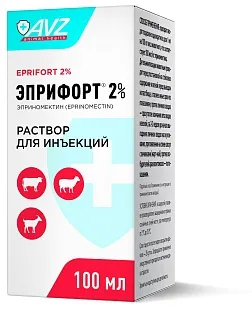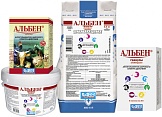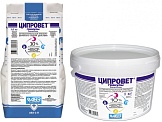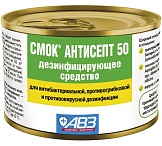Product benefits:
- Low toxicity index compared to other macrocyclic lactones
- Single introduction
- Protection against re—infection - 21 days
- A small volume of the injected solution per head — 1 ml / 100 kg
- The waiting period for milk is 0 days
Chemical composition and pharmacological properties
EPRIFORT® 2% belongs to the pharmacotherapeutic group — antiparasitic drugs of the class of macrocyclic lactones.
The drug in 1 ml as an active substance contains eprinomectin — 20 mg, as well as auxiliary substances: butyl-hydroxytoluene, dimethyl sulfoxide and stabilized glycerin.
Eprinomectin, which is part of the drug, has a wide spectrum of antiparasitic action against imaginal and larval forms of nematodes of the gastrointestinal tract and lungs, sarcoptoid mites, insects and gadfly larvae parasitizing animals.
The mechanism of antiparasitic activity of eprinomectin consists in selective binding to glutamate receptors of chlorine ion channels located in the cell membranes of nerve and muscle cells, in increasing their permeability to chlorine ions and hyperpolarization of nerve and muscle cell membranes, which leads to impaired conduction of nerve impulses, paralysis and death of parasites.
After subcutaneous administration of the drug, eprinomectin is resorbed from the injection site, remains for a long time in therapeutic concentrations in the body of animals, providing parasitocidal action and protection from re-infection for a long period (up to 21 days).
Indications
EPRIFORT® 2% is used for therapeutic and prophylactic purposes in cattle, sheep and goats with nematodes of the gastrointestinal tract and lungs, including strongylatosis, protostrongylidosis, trichocephalosis, strongyloidosis, dictyoculosis, telaziosis and arachnoentomosis, including psoroptosis, chorioptosis, sarcoptosis, demodecosis, siphunculatosis, bovicolysis , wolfarthiosis, melophagosis, hypodermatosis and estroz.Contraindications
Increased individual sensitivity to the drug components. Do not use in laying hens (due to drug accumulation in eggs); in contagious and debilitated animals; males and females within lay period; during the first half (sheep, goats and sows) and the first trimester of pregnancy (cows).Dosage and administration
The drug is administered subcutaneously once at a dose of 1 ml per 100 kg of animal weight, which corresponds to 200 mcg / kg of eprinomectin.
Deworming of animals is carried out before stabling and in the spring before being taken to pasture, as well as at other times according to indications; against gadfly larvae — immediately after the end of the gadfly summer and in the spring, 2-3 weeks before the fallout of gadfly larvae for pupation, when capsules with larvae appear on the back (March-May); against pathogens of arachnoentomoses — according to indications.
If the repeated administration of the drug is missed, it should be applied as soon as possible in the dose and according to the scheme established by this instruction
Adverse events
After using EPRIFORT® 2%, undesirable reactions may occur: often (more than 1%, but less than 10%) — anxiety, shaking of the head, tail twitching, vocalization, scratching of the injection site; rarely (more than 0.01%, but less than 0.1%) — excitement, increased salivation, increased defecation and urination, ataxia; very rarely (less than 0.01%) — muscle tremor, ataxia and convulsions. These symptoms usually pass spontaneously, do not require the use of medications. When allergic reactions occur, the use of the drug is discontinued and antihistamines and symptomatic therapy are prescribed to the animal.In some cases, 24 hours after the administration of the drug, edema and compaction may form at the injection site, which usually resolve spontaneously within 7 days, but the compaction at the injection site may persist for more than 21 days. Edema may be accompanied by mild or moderate pain. This reaction takes place independently and does not require additional treatment.
With an overdose of the drug, the animal may experience anorexia, diarrhea, salivation, motor discoordination, depression, mydriasis, muscle tremor, convulsions. In these cases, the animal is prescribed symptomatic therapy.
Special warnings
Contraindications to the use of the drug are increased individual sensitivity of the animal to the components of the drug (including in the anamnesis), severe renal and liver dysfunction. Animals that are emaciated and sick with infectious diseases are not subject to treatment.The use of the drug to females during pregnancy and feeding of young animals is determined by the attending veterinarian based on an assessment of the ratio of benefit to the possible risk of its use.
Do not use the drug simultaneously with other antiparasitic agents containing macrocyclic lactones, piperazine and drugs that inhibit cholinesterase.
Slaughter for cattle meat is carried out no earlier than 21 days, sheep — 42 days, goats — 31 days after the last administration of the drug. The meat of animals forcibly killed before the expiration of the specified period can be used for feeding fur-bearing animals or for the production of meat and bone meal. Milk of dairy animals is allowed to be used for food purposes without restrictions.
Storage
The drug is stored in a closed manufacturer's packaging in a place protected from direct sunlight, at a temperature from 2 ° C to 25 ° C.Pharmaceutical form
The drug is produced packaged in 10, 20, 50, 100 and 500 ml in glass vials of the appropriate capacity, capped with rubber stoppers, reinforced aluminum or aluminum-plastic caps with the control of the first opening. Bottles of 10, 20, 50 and 100 ml are individually packed in a cardboard pack. Each consumer package is provided with instructions for the use of the drug.


















